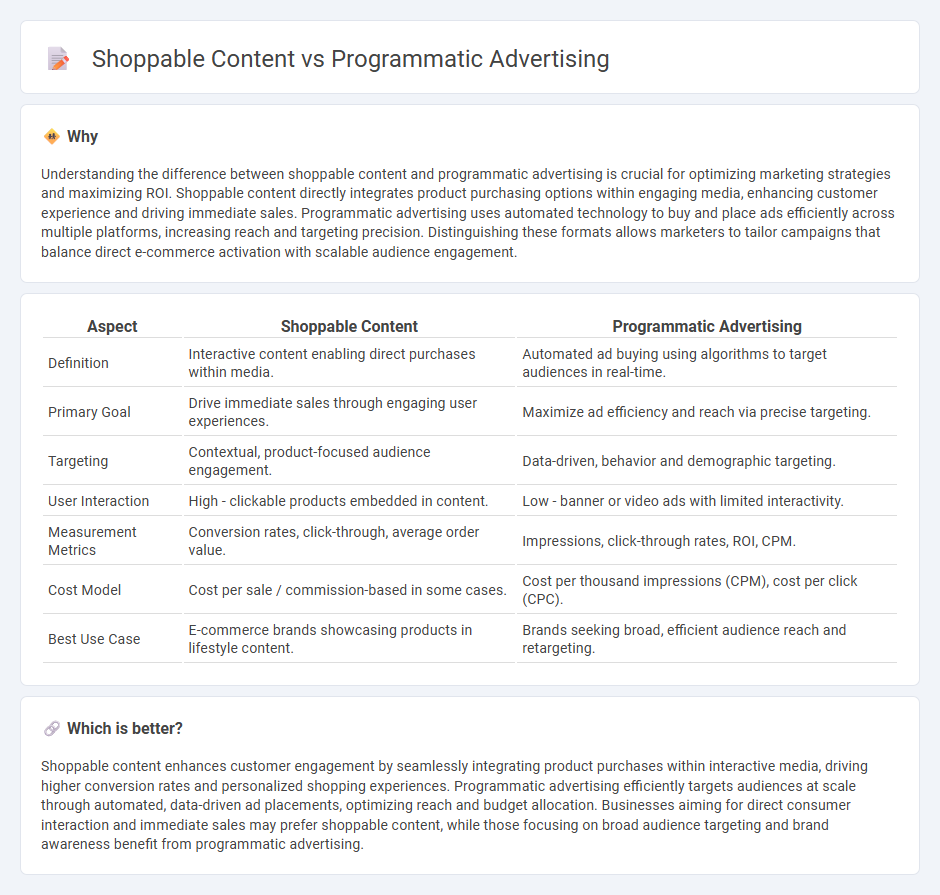
Shoppable content integrates direct purchasing options within digital media, enhancing user engagement and streamlining the path from discovery to sale. Programmatic advertising leverages automated technology to target specific audiences efficiently through real-time bidding across multiple channels. Explore the distinct advantages of these marketing strategies to boost your digital campaign effectiveness.
Why it is important
Understanding the difference between shoppable content and programmatic advertising is crucial for optimizing marketing strategies and maximizing ROI. Shoppable content directly integrates product purchasing options within engaging media, enhancing customer experience and driving immediate sales. Programmatic advertising uses automated technology to buy and place ads efficiently across multiple platforms, increasing reach and targeting precision. Distinguishing these formats allows marketers to tailor campaigns that balance direct e-commerce activation with scalable audience engagement.
Comparison Table
| Aspect | Shoppable Content | Programmatic Advertising |
|---|---|---|
| Definition | Interactive content enabling direct purchases within media. | Automated ad buying using algorithms to target audiences in real-time. |
| Primary Goal | Drive immediate sales through engaging user experiences. | Maximize ad efficiency and reach via precise targeting. |
| Targeting | Contextual, product-focused audience engagement. | Data-driven, behavior and demographic targeting. |
| User Interaction | High - clickable products embedded in content. | Low - banner or video ads with limited interactivity. |
| Measurement Metrics | Conversion rates, click-through, average order value. | Impressions, click-through rates, ROI, CPM. |
| Cost Model | Cost per sale / commission-based in some cases. | Cost per thousand impressions (CPM), cost per click (CPC). |
| Best Use Case | E-commerce brands showcasing products in lifestyle content. | Brands seeking broad, efficient audience reach and retargeting. |
Which is better?
Shoppable content enhances customer engagement by seamlessly integrating product purchases within interactive media, driving higher conversion rates and personalized shopping experiences. Programmatic advertising efficiently targets audiences at scale through automated, data-driven ad placements, optimizing reach and budget allocation. Businesses aiming for direct consumer interaction and immediate sales may prefer shoppable content, while those focusing on broad audience targeting and brand awareness benefit from programmatic advertising.
Connection
Shoppable content integrates product links directly within engaging media, enabling seamless consumer purchases and driving higher conversion rates. Programmatic advertising uses automated algorithms to deliver targeted ads based on user data, maximizing the relevance of shoppable content exposure. Together, they create a dynamic marketing ecosystem that personalizes shopping experiences and boosts revenue efficiency.
Key Terms
**Programmatic Advertising:**
Programmatic advertising leverages automated technology and data-driven algorithms to buy and optimize digital ad placements in real-time, enhancing targeting precision and campaign efficiency across multiple channels. It utilizes audience segmentation, machine learning, and predictive analytics to deliver personalized ads, maximizing ROI and reducing manual processes. Discover how programmatic advertising transforms your marketing strategy by driving higher engagement and conversions.
Real-Time Bidding (RTB)
Real-Time Bidding (RTB) is a key component of programmatic advertising, enabling advertisers to bid on ad inventory in real time and target audiences with precision using data-driven algorithms. In contrast, shoppable content integrates interactive elements within media, allowing consumers to make purchases directly without leaving the content, focusing more on user engagement than automated bidding processes. Explore the nuances of RTB's impact on programmatic advertising effectiveness and its distinction from shoppable content strategies.
Demand-Side Platform (DSP)
Demand-Side Platforms (DSPs) drive programmatic advertising by automating the purchase of digital ads and optimizing real-time bidding across multiple channels for targeted audience reach. Shoppable content integrates seamless e-commerce elements within digital media, enabling direct purchases but relies less on DSPs and more on content management and user experience platforms. Explore how DSP technology enhances precision targeting and efficiency in programmatic campaigns compared to the interactive potential of shoppable content.
Source and External Links
What is programmatic advertising? - Programmatic advertising is the automated buying of digital ad space using AI and real-time bidding to connect advertisers with publishers efficiently and in real time.
Programmatic Advertising - What It Is and How It Works - It is the use of advertising technology and automation to purchase digital ads across web, mobile, video, and social media with machine learning optimizing ad delivery to the right audience.
What Is Programmatic Advertising? How Does It Work? - Programmatic advertising automates media buying using algorithms to serve ads precisely to the right user at the right time without manual price negotiations or placements.
 dowidth.com
dowidth.com